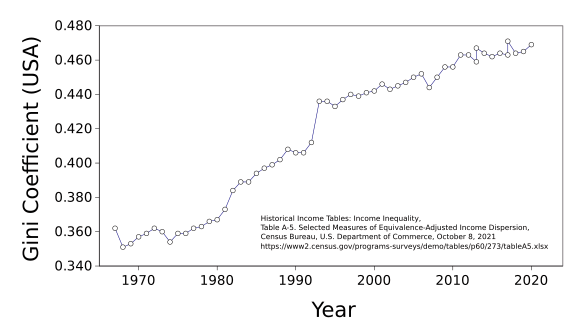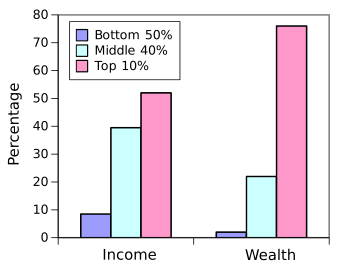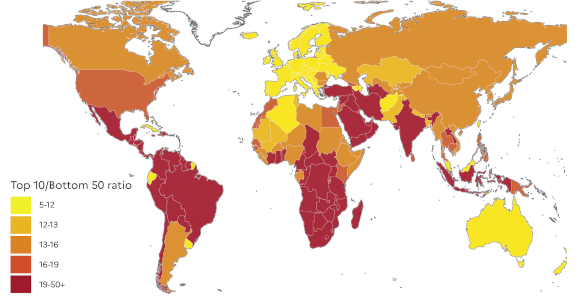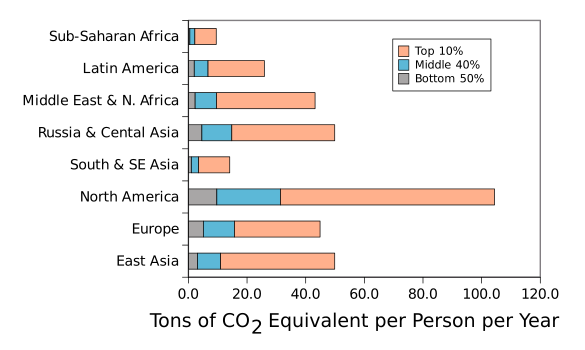World Inequality 2022
January 24, 2022
Tikalon's home in
Northern New Jersey is just a short
commuter train ride from
New York City. That's the reason why our local
television news originates from the many
New York City television stations and is intermixed with New York City news and news about
Connecticut, the third member of
our tri-state area. The major news of the first month of
2022 was the
January 9, 2022, Bronx apartment fire that
killed seventeen people, including eight
children.[1] It was the deadliest apartment fire in New York City in more than 30 years.[1]
This fire was in a 129 unit
high-rise apartment building
constructed in 1972 to provide
affordable housing. Housing of this type is
colloquially known as
project housing, and such housing is typically housing of
last resort for many people. The cause of the fire was apparently a
malfunctioning electric space heater in one apartment. Although the fire was largely confined to that one apartment, two self-closing
doors somehow stayed open, this caused the spread of thick
smoke, and it caused the
smoke inhalation deaths of all
decedents.[1] Since this building had received
federal subsidies, it appears that
fire protection rules about
fire sprinklers were different from city requirements.[1]
I was a member of the
research laboratory safety team at my previous
employer, and we were
trained to look for the
root cause of laboratory
accidents in order to institute
policies to prevent similar accidents. If you examine this tragic fire, you might focus on electric space heaters and faulty door
mechanisms as root causes. My root cause assessment is different. The root cause of these deaths was
poverty.
Technology has given us many
marvels, but we're still a long way from
utopia. Everyone seems to have a
smartphone, but many people still have difficulty
paying for the
basic necessities of
food,
shelter, and
health care. There was a thriving
middle class in the
United States in the early
1950s. At that time, single
income households could maintain a very
comfortable lifestyle, as
parodied in the
song, "
Pleasant Valley Sunday," by
The Monkees. Since that time,
job opportunities for the middle class have decreased to the point at which even a two income family has a difficult life experience. At the same time, continuing the validity of the
centuries-old catchphrase, "
The rich get richer and the poor get poorer,"
wealth has become increasingly concentrated in a very small number of people.
I've written about
wealth inequality in several previous articles (
The Entropy of Nations, January 22, 2014,
Income Inequality and Geometrical Frustration, March 20, 2017, and
Transitioning to Utopia, August 29, 2016). One descriptive measure of
income inequality and wealth inequality is the
Gini coefficient, the value of which ranges from zero to one. Perfect
equality is expressed by a Gini coefficient of zero, whereas a Gini coefficient near one represents the case in which just a few individuals have most of the wealth. The
trend in the coefficient, as shown in the figure, is quite instructive.

Gini coefficient for the United States from 1967-2020. (Graphed using Gnumeric from United States Census Bureau data in ref. 2, and also uploaded to Wikimedia Commons. Click for larger image.)
The
World Inequality Lab of the
Paris School of Economics has recently issued its 2022 World Inequality Report, licensed under the
Creative Commons License 4.0, that contains income and wealth inequality data through 2021.[3-4] This inequality can be seen in the following table that lists the numbers of global
millionaires and
billionaires, and a chart that summarizes income and wealth distribution. In 2021, there were 168 individuals with a
net worth of greater than $10 billion.
According to Wikipedia, there are about 200
countries whose annual
budget is less than $10 billion.
Table 1. Global millionaires and billionaires, 2021
| Wealth Group |
Number |
| 1 million - 10 million |
60,319,510 |
| 10 million - 100 million |
1,769,200 |
| 100 million - 1 billion |
73,710 |
| 1 billion - 10 billion |
2,582 |
| 10 billion - 100 billion |
159 |
| > 100 billion |
9 |

Global inequality in 2021.
Based on purchasing power parity, the bottom 50% captures just 8% of total income and 2% of household wealth, while the top 10% has 52% of total income and 76% of total household wealth.
(Data from fig. 1 of ref. 3,[3] graphed using Gnumeric. Click for larger image.)
According to the report, the
average adult individual earned $23,380 and owns $102,600 in 2021. While this appears to be a comfortable average, an individual from the top 10% earns $122,100 per year, whereas an individual from the poorest half makes $3,920 per year.[3] Inequality in wealth is more extreme than income inequality, with the poorest half having essentially no net worth (just 2% of the total), while the richest 10% of the global population own 76% ($771,300 on average) of all wealth.[3]
Europe is the most equal region of the world, while the
Middle East and
North Africa are the most unequal. The world map of inequality (see figure) reveals that national average income is not a good
predictor of inequality, since high-income countries, such as the United States, are very unequal.[3]

World map of income inequality. Europe is more equitable than the United States. income is measured after pension benefits and unemployment payments received, but before taxes paid. For Brazil, the bottom 50% earns 29 times less than the top 10%. (Fig. 3 of ref. 3.[3] Image licensed under the Creative Commons License 4.0. Click for larger image.)
Income and wealth inequality has increased nearly everywhere since the 1980s, the probable cause being
deregulation and
liberalization programs in many countries.[3] The rise in inequality hasn't been uniform. For example, the United States,
Russia and
India have seen a rapid rise in inequality, while European countries and
China have had a relatively smaller rise.[3] The current global inequality levels are close to those of the early
20th century, at the peak of
Western imperialism.[3] Interestingly, while inequality has increased within most countries, the inequality between countries has declined.[3] There was a considerable decrease from a factor of fifty to a factor of forty in the gap between the average incomes of the richest 10% of countries and the average incomes of the poorest 50% of countries.[3] However, there was a significant increase in inequality within countries with the gap between the average incomes of the top 10% and the bottom 50% of individuals within countries nearly doubling.[3]
Affluence, at least among the very rich, has come with a correspondingly large
carbon footprint, with
North America being a prime
culprit (see figure).

per capita carbon dioxide equivalent emission by region in 2019. The personal carbon footprints include emissions from domestic consumption, public and private investments as well as import and export of carbon embedded in goods and services traded with the rest of the world, with emissions split equally among household members. (Data from fig. 15 of ref. 3,[3] graphed using Gnumeric. Click for larger image.)
References:
- New York fire: Officials pledge support after 17 die in unspeakable tragedy. BBC News, January 10, 2022.
- Historical Income Tables: Income Inequality, Table A-5. Selected Measures of Equivalence-Adjusted Income Dispersion, Census Bureau, U.S. Department of Commerce, October 8, 2021 (xlsx file).
- Lucas Chancel (Lead author), Thomas Piketty, Emmanuel Saez, and Gabriel Zucman, et al., World Inequality Report 2022, World Inequality Lab, 2021 (PDF File). This report is licensed under the Creative Commons License 4.0.
- Dedicated website for the World Inequality Report 2022, World Inequality Lab (wid.world).
Linked Keywords: Tikalon; home; Northern New Jersey; commuter rail; commuter train ride; New York City; television news; New York City television stations; Connecticut' New York metropolitan area; tri-state area; 2022; January 9, 2022, Bronx apartment fire; death; killed; child; children; high-rise building; construction; constructed; subsidized housing in the United States; affordable housing; colloquialism; colloquially; last resort; malfunction; malfunctioning; electricity; electric; space heater; door; smoke; smoke inhalation; decedent; federal government of the United States; subsidy; fire protection; fire sprinkler; research laboratory; safety; team; employment; employer; training; trained; root cause; accident; business policies; mechanism (engineering); poverty; Technology; marvel; utopia; smartphone; payment; pay; basic need; basic necessity; food; shelter (building); health care; social class in the United States; middle class; 1950s; income; household; comfort; comfortable; lifestyle (sociology); parody; song; Pleasant Valley Sunday; The Monkees; employment; job; opportunity; century; centuries-old; catchphrase; the rich get richer and the poor get poorer; wealth; distribution of wealth; wealth inequality; The Entropy of Nations, January 22, 2014; Income Inequality and Geometrical Frustration, March 20, 2017; Transitioning to Utopia, August 29, 2016; economic inequality; Gini coefficient; trend; Gini Coefficient for the United States from 1967-2020; Gnumeric; United States Census Bureau; data; Wikimedia Commons; World Inequality Lab; Paris School of Economics; Creative Commons License 4.0; millionaire; billionaire; net worth; government budget; country; countries; budget; purchasing power parity; income; household; average; adult; Europe; Middle East; North Africa; prediction; predictor; world map of income inequality; equitable; pension benefit; unemployment payment; tax; Brazil; deregulation; liberalization; Russia; India; China; 20th century; Western imperialism; affluence; carbon footprint; North America; culprit; per capita carbon dioxide equivalent emission by region in 2019; global warming potential; carbon dioxide equivalent emission; consumption (economics); domestic consumption; investment; import; export; goods and services; trade; traded; World Inequality Report 2022.